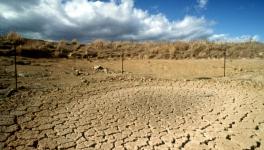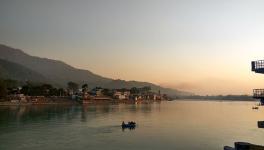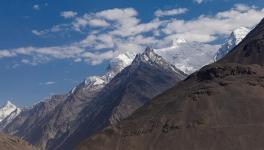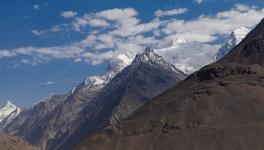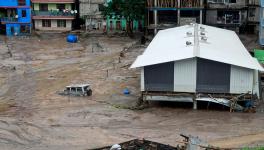India Can Save up to $1.3 Trillion in Health Benefits by 2030 by Meeting Air Quality Standards, Say Experts

Representational picture. (Image Credit: Wikimedia Commons)
Patna: Toxic air in South Asia has risen more than 50% since the start of this century. This has affected gross domestic product in the region and shortened the average lifespan in India, Nepal, Bangladesh and Pakistan by five years, versus four months for the average American, said leading regional and international scientists at an even held in Kathmandu, Nepal.
According to experts , populations across the region are exposed to polluted air, exposure and vulnerability are greatest among those living in poverty – including those working long hours outdoors, communities living close to landfills or factories, or families unable to afford clean alternatives to solid fuels for cooking, lighting, or heating.
“The moral and social case for action on clean air has long been clear, but the economic cost of this public health crisis is perhaps evenly striking,” Michal Krzyzanowski, visiting Professor at Imperial College London, said at a launch of initiative of the Kathmandu-based International Centre for Integrated Mountain Development (ICIMOD) that has partnered with US-based Health Effects Institute (HEI), to drive action that tackles hazardous air pollution.
“Studies in Europe find that for every euro invested in improving air quality, economies get €10 back in productivity and health”, he said, as per an ICIMOD release issued after the event.
The Indo-Gangetic Plain and Himalayan Foothills (IGP-HF) region airshed includes some of the world’s most polluted countries. “Air pollution costs the global economy $8 trillion a year, and in South Asia wipes out more than 10% of gross domestic product per annum,” said Izabella Koziell, Deputy Director General of ICIMOD, at the event.
She said, “The longer-term health and productivity costs, and the fall-out from the temperature rises that air pollution accelerates, will be higher still. These are costs that low- and middle-income countries in this region can ill afford. Stakeholders from across the region simply have to come together to shift the dial on dirty air.”
The experts opined that India alone could save up to $1.3trillion in health benefits by 2030 by meeting air quality standards. Pakistan is estimated to lose $1 billion a year in environmental degradation chiefly due to air pollution.
Rapid industrialisation and population growth are key drivers of declining air quality in South Asia, with sources including transport, industry, agriculture, waste burning, and domestic solid fuel use.
At the Kathmandu event, HEI and ICIMOD brought together representatives from regional ministries of health, forest and
environment, and medical research councils to explore the nexus between air pollution, health and social exclusion; with particular focus on the role of physicians in building support for faster
action among publics and policymakers. The event was supported by the United Kingdom Foreign, Commonwealth and Development Office under the Climate Action for Resilient Asia initiative.
Speaking at the opening of the event, Baumgartner said, “You look at the dramatic decrease in pollution in China over the last decade – where pollution has fallen 42% – to see what’s possible with the right political will and public support. While pollution is a pernicious challenge, it is one that is eminently fixable, is hugely popular with the public, and where the long-term benefits of action far outweigh the upfront investments.”
Om Kurmi, Associate Professor at Coventry University, UK ,who has started a major family-cohort study of the health impacts of air pollution on children in two regions of Nepal, following similar research conducted in China, said, “Poverty is a huge driver of exposure to air pollution in South Asia. People working in polluting industries or with pesticides lack personal protective gear and are unable to afford the more drastic measures that more affluent families are adopting, such as buying air purifiers, moving out of urban centres, or sending children to schools outside cities. This lack of economic means further exacerbates existing inequalities – with early exposure resulting in health issues that ricochet down a child’s entire life-course and determine long-term socioeconomic outcomes.”
Pallavi Pant, Head of Global Health at the Health Effects Institute and a co-organiser of the event, said, “Global progress towards clean air shows that sustained, evidence-based programs can achieve clean air and improve health for all. However, in South Asia, more than two million deaths were linked to air pollution in 2021 alone, with many more people living with chronic diseases. In hopeful news, the research on the link between air pollution and health in the region has grown significantly, and
the workshop will showcase some of the data that is available to inform action.”
HEI has recently developed a public database of peer-reviewed research on air pollution and health in South Asia, which features over 1,000 studies from across the region and can be used by
decision-makers to take informed policy action.
The regional momentum follows a step-change in global recognition of the health impact of climate policies, with health ministers attending the climate talks for the first time last year and the COP Presidency and World Health Organisation issuing a declaration on climate and health.
The writer is a freelance journalist based in Patna, Bihar.
Get the latest reports & analysis with people's perspective on Protests, movements & deep analytical videos, discussions of the current affairs in your Telegram app. Subscribe to NewsClick's Telegram channel & get Real-Time updates on stories, as they get published on our website.











